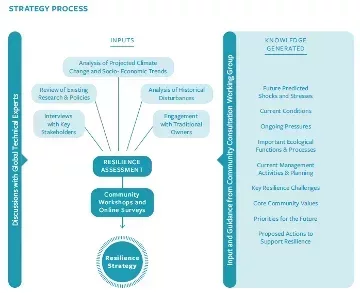A case study by the Reef Resilience Network and partners outlines lessons learned from a stakeholder engagement process used for resilience planning for the Ningaloo Coast in Western Australia.
Local managers in Ningaloo worked with Resilient Reefs Initiative partners to build momentum, reduce barriers and meaningfully engage their community to design a Resilience Strategy for the Ningaloo Coast.

To develop the strategy for Ningaloo, over a period of eight months, Resilient Reefs Initiative partners engaged with stakeholders to understand their concerns, values, and priorities; provided information where necessary; and then co-designed actions which addressed key threats to coral reefs and communities. Stakeholders involved in the process included local councils, other management authorities, community groups, local businesses, indigenous groups, scientists, community members, and specific interest groups and industries.
Key lessons and recommendations from the process include:
- Once key stakeholders have been identified, as well as their concerns and how to engage with them, building momentum and interest in the process to get participation is needed
- In all circumstances there will be barriers to participation. If these barriers can be reduced, more people will be able to engage, and the process is more likely to be more successful
- In this process, a key concept was allowing stakeholders to engage meaningfully. This was about ensuring all participants felt comfortable contributing and that their views were being considered equitably

